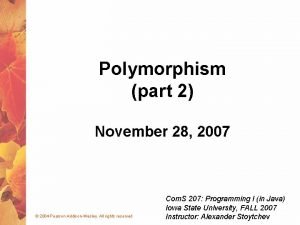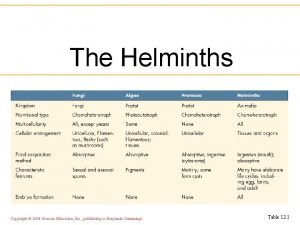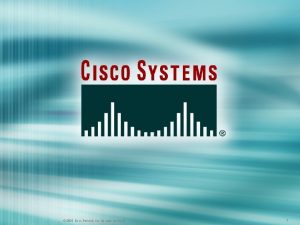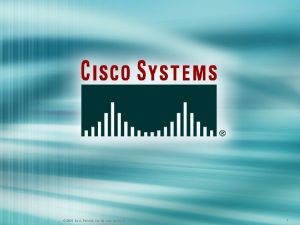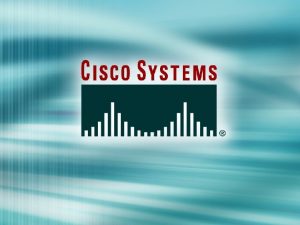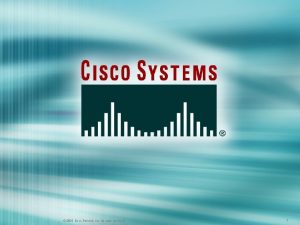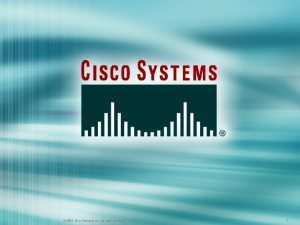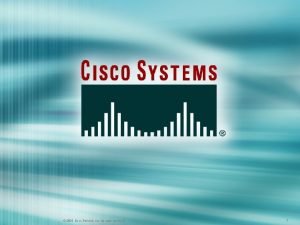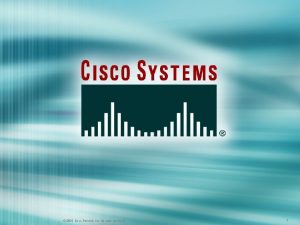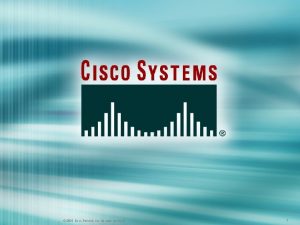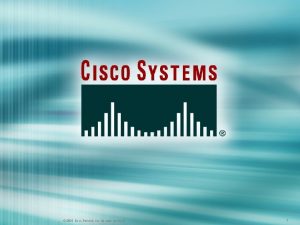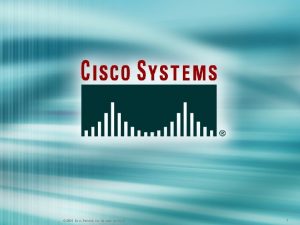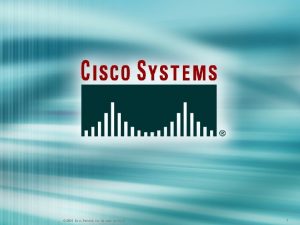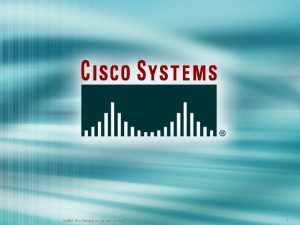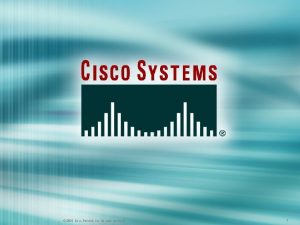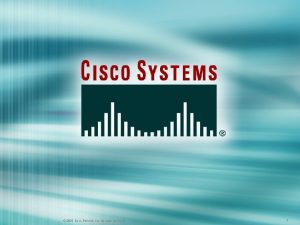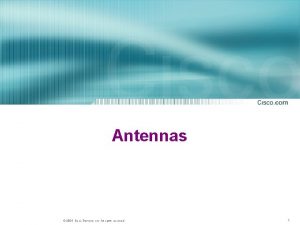2004 Cisco Systems Inc All rights reserved Cisco







































- Slides: 39

© 2004, Cisco Systems, Inc. All rights reserved.

Cisco Sales Essentials © 2004, Cisco Systems, Inc. All rights reserved. 7 -2

Cisco Sales Essentials IP Telephony © 2004, Cisco Systems, Inc. All rights reserved. 7 -3

Course Outline Cisco Sales Essentials Introduction • Course Overview • Why Cisco? • AVVID Solutions • Campus LAN • Wireless LAN • WAN • IP Telephony • Security and VPN • Network Management • Service and Support • Optical Networking • Storage Networking • Content Networking • Video • High-Speed Access Tools and Resources © 2004, Cisco Systems, Inc. All rights reserved. CSE v 2. 0— 7 -4

Introduction This lesson includes the following information: • IP telephony components that enable voice traffic to be transmitted over IP data networks • Cisco IP Telephony product offerings • Types of customer situations that would benefit from IP telephony solutions © 2004, Cisco Systems, Inc. All rights reserved. CSE v 2. 0— 7 -5

Objectives Upon completion of this lesson, you will be able to perform the following tasks: • Identify the definition of IP telephony and the function of technologies that support IP telephony • Describe how IP components replace traditional network components and place them in a network map • Identify the features and functionality of the Cisco product series that support IP telephony • Identify opportunity indicators for IP telephony © 2004, Cisco Systems, Inc. All rights reserved. CSE v 2. 0— 7 -6

Business Example: Mobility Manufacturing company: • Designers move throughout the facility for different projects. • The company needs to relocate phones extensions and laptops to new work areas easily. • The IT staff must reconfigure the phone network for each move. • The company hopes to decrease the complexity of its systems and limit the growth of the IT staff. © 2004, Cisco Systems, Inc. All rights reserved. CSE v 2. 0— 7 -7

Business Example: Sophisticated Call Handling • Company that develops • Customer needs: computerized control systems – Streamline the phone process • Three customer service centers – Reduce customer wait times • A single agent who receives all calls and – Improve employee productivity routes requests to the appropriate engineers © 2004, Cisco Systems, Inc. All rights reserved. CSE v 2. 0— 7 -8

The Solution • Traditionally, organizations use separate voice and data networks. • Restrictions of separate networks: – Require separate staffs to maintain them – Are not designed to allow easy mobility – Do not always take advantage of new, sophisticated applications • IP telephony can eliminate such restrictions. © 2004, Cisco Systems, Inc. All rights reserved. CSE v 2. 0— 7 -9

Voice Networks • Two types of networks today: – Voice – Data • Legacy voice networks: – Use analog telephones – Connect through the public switched telephone network (PSTN) – Are circuit switched – Follow a single, dedicated path through the network – Send data constantly in order to ensure intact signals © 2004, Cisco Systems, Inc. All rights reserved. CSE v 2. 0— 7 -10

Data Networks Packet IP Address: 66. 147. 232. 123 • Data networks – Use routers and IP addresses to connect computers and other networks – Are packet switched – Send data in chunks, for signals do not need to arrive intact • The Internet is the largest packet-switched network. © 2004, Cisco Systems, Inc. All rights reserved. CSE v 2. 0— 7 -11

Enterprise Networks • Telephones connect to a private branch exchange (PBX) or Centrex. • Switching equipment provides telephone features: • Switching equipment connects the organization to the PSTN. – Voice messaging – Call transferring – Call forwarding © 2004, Cisco Systems, Inc. All rights reserved. CSE v 2. 0— 7 -12

LANs and WANs • Most organizations have LANs for their data networks. • LANs use routers to connect to WANs. – The Internet is a public WAN. – A company intranet is a private WAN. © 2004, Cisco Systems, Inc. All rights reserved. CSE v 2. 0— 7 -13

Network Convergence A single network: • Is easier to maintain than two separate networks • Is simpler to manage than two separate networks • Scales easily to include new users • Can be upgraded to accommodate new, sophisticated data and voice applications • Dramatically enhances communications flexibility and effectiveness © 2004, Cisco Systems, Inc. All rights reserved. CSE v 2. 0— 7 -14

IP Telephony Definition IP Address: 66. 156. 456. 987 IP Address: 66. 147. 232. 123 • Uses IP addressing • Enables two-way transmission of voice traffic • Sends voice transmissions over packet-switched TCP/IP networks © 2004, Cisco Systems, Inc. All rights reserved. CSE v 2. 0— 7 -15

Quality of Service IP networks: Qo. S: • Send data packets with variable • Prioritizes voice traffic over transfer rates • Resend data packets if packets have been lost data traffic • Ensures that voice data arrives intact • Send voice packets sequentially and quickly using Qo. S © 2004, Cisco Systems, Inc. All rights reserved. CSE v 2. 0— 7 -16

Migration to IP Telephony Gradual, methodical implementation allows organizations to: • Leverage existing infrastructure • Become familiar with new technology • Slowly change an existing network © 2004, Cisco Systems, Inc. All rights reserved. Installing IP phones and callmanagement software reveals benefits of IP telephony: • Easier network management • Reduced toll charges • Simpler moves, adds, and changes CSE v 2. 0— 7 -17

IP Telephony Components Applications Client Call Management Infrastructure Clients: Voice applications: • End-user devices • Advanced call-handling software Infrastructure: Call management: • Switches • Routers • Call-processing software • Call-processing hardware © 2004, Cisco Systems, Inc. All rights reserved. CSE v 2. 0— 7 -18

Cisco Sales Essentials Understanding IP Telephony Terms © 2004, Cisco Systems, Inc. All rights reserved. 7 -19

Cisco IP Telephony Solutions © 2004, Cisco Systems, Inc. All rights reserved. CSE v 2. 0— 7 -20

Cisco IP Clients Cisco 7900 Series IP phones support : Cisco Soft. Phone: • Is a Windows-based, PC application • Traditional telephone functions • Specialized IP telephony functions • Allows for integration of contact © 2004, Cisco Systems, Inc. All rights reserved. directories • Features a drag-and-drop interface for conference calls CSE v 2. 0— 7 -21

Cisco IP Client Positioning Cisco 7900 Series positioning: Cisco 7900 Series features: • 7905 and 7910 for lobbies • 7940 G and 7960 G for workstations • 7935 for conference rooms • Large, pixel-based LCD • Internet access • E-mail access © 2004, Cisco Systems, Inc. All rights reserved. CSE v 2. 0— 7 -22

Cisco IP Telephony Infrastructure Small Office/Branch office: • Catalyst 3550 -PWR switch Enterprise: • Catalyst 4000 Series modular switches Service provider: • 6000 Series multiservice switches • 6500 Series modular, multiservice switches • 7800 Series Media Convergence Server and © 2004, Cisco Systems, Inc. All rights reserved. call-processing software CSE v 2. 0— 7 -23

Cisco Voice Gateways • Voice gateways connect traditional analog devices to an IP network. © 2004, Cisco Systems, Inc. All rights reserved. • The VG 248 Analog Phone Gateway and Analog Adapter 180 Series connect these legacy communication devices to an IP network: – Voice mail – Analog phones – Fax machines CSE v 2. 0— 7 -24

Cisco Routers as Voice Gateways • 2600 XM and 7200 series routers can function as voice gateways. • Voice interface modules and high-density voice modules: – Can be installed on these routers – Connect traditional telephony equipment to an IP network © 2004, Cisco Systems, Inc. All rights reserved. CSE v 2. 0— 7 -25

Cisco Call. Manager • Provides standard call processing for IP phones and softphones: – Signaling • Includes applications such as voice mail and audioconferencing • Is installed on a network server – Connection service © 2004, Cisco Systems, Inc. All rights reserved. CSE v 2. 0— 7 -26

Cisco IOS Telephony Service Enables network operators to easily: © 2004, Cisco Systems, Inc. All rights reserved. • Configure IP telephony devices • Monitor IP telephony devices • Manage IP telephony devices CSE v 2. 0— 7 -27

Cisco Call. Manager Express • Feature of Cisco IOS software • Provides call processing for up to 100 Cisco IP phones • Allows customers to scale IP telephony to a small site or branch office with a feature-rich solution © 2004, Cisco Systems, Inc. All rights reserved. CSE v 2. 0— 7 -28

Cisco Survivable Remote Site Telephony (SRST) • Offers emergency planning features for enterprise networks • Allows IP phones at remote sites to function during a server shutdown or WAN failure • Enables Cisco 1750, 2600, 3700, and 7200 routers at remote sites to assume the Call. Manager role to enable basic IP telephony functions © 2004, Cisco Systems, Inc. All rights reserved. CSE v 2. 0— 7 -29

Cisco Voice Applications • Are interoperable and network-based • Allow network operators to expand IP telephony functions © 2004, Cisco Systems, Inc. All rights reserved. – Example: Cisco Conference Connection is an IP-based audioconferencing solution that provides a web-based interface for participants and security for sensitive conferences CSE v 2. 0— 7 -30

Cisco IP Contact Center Enterprise • Is an integrated solution that enables companies to rapidly deploy a distributed contact center • Segments customers • Monitors resource availability • Delivers each contact to the most appropriate resource anywhere in the enterprise • Clear migration strategy from traditional time-division multiplexing (TDM) automatic call distributor (ACD) deployments • Leverages customers current investment to migrate to IP at their own pace © 2004, Cisco Systems, Inc. All rights reserved. CSE v 2. 0— 7 -31

Cisco IPCC Express • For departmental, enterprise branch, or small- to medium-size companies to deploy an entry-level or mid-market contact center solution • Integrates into Cisco Call. Manager • Delivers sophisticated call routing, contact management, and administration features • Offers ease of installation, configuration, and application hosting • Supports up to 200 agents and 72 supervisor positions © 2004, Cisco Systems, Inc. All rights reserved. CSE v 2. 0— 7 -32

Cisco Unity • Is a Unified Communications Solution • Helps enterprises improve customer service and productivity by allowing employees to manage messages and calls from anywhere, at anytime, regardless of access device or media type • Integrates with desktop applications, such as Microsoft Outlook and Lotus Notes © 2004, Cisco Systems, Inc. All rights reserved. CSE v 2. 0— 7 -33

Cisco Unity Express • Is a network module for the Cisco 2600 XM, 2691, and 3700 Series access routers • Provides integrated, entry-level, voice mail, and automated attendant services • Operates under Cisco Call. Manager Express control • Offers a cost-effective voice-mail solution for up to 100 users working in an enterprise small branch office or small business © 2004, Cisco Systems, Inc. All rights reserved. CSE v 2. 0— 7 -34

Cisco Sales Essentials Human IP Telephony Network Exercise © 2004, Cisco Systems, Inc. All rights reserved. 7 -35

Opportunity Indicator: Multiple Call Centers • Opportunity indicator: – Multiple customer service call centers the use the PSTN to route calls • Cisco IPCC solution: – Improves customer service – Increases the number of transactions – Controls costs © 2004, Cisco Systems, Inc. All rights reserved. CSE v 2. 0— 7 -36

Opportunity Indicator: Toll Bypass • Opportunity indicator: – Manufacturer that wants to bypass toll calls • Cisco Call. Manager solution: – Improves customer service – Improves productivity – Reduces toll-call costs © 2004, Cisco Systems, Inc. All rights reserved. CSE v 2. 0— 7 -37

Summary This lesson covered the following main topics: • The definition of IP telephony and the function of technologies that support IP telephony • How IP components replace traditional network components and where to place them in a network map • The features and functionality of the Cisco product series that support IP telephony • Opportunity indicators for IP telephony © 2004, Cisco Systems, Inc. All rights reserved. CSE v 2. 0— 7 -38

Cisco Sales Essentials Cosmopolitan Coffee Case Study © 2004, Cisco Systems, Inc. All rights reserved. 7 -39
 2012 pearson education inc
2012 pearson education inc Pearson education inc. all rights reserved
Pearson education inc. all rights reserved 2010 pearson education inc
2010 pearson education inc Pearson education inc all rights reserved
Pearson education inc all rights reserved Pearson education inc. all rights reserved
Pearson education inc. all rights reserved Specification by example
Specification by example Copyright 2015 all rights reserved
Copyright 2015 all rights reserved All rights reserved sentence
All rights reserved sentence Creative commons vs all rights reserved
Creative commons vs all rights reserved Confidential all rights reserved
Confidential all rights reserved Sentinel-controlled repetition
Sentinel-controlled repetition Copyright © 2015 all rights reserved
Copyright © 2015 all rights reserved Microsoft corporation. all rights reserved.
Microsoft corporation. all rights reserved. Microsoft corporation. all rights reserved.
Microsoft corporation. all rights reserved. Microsoft corporation. all rights reserved.
Microsoft corporation. all rights reserved. Dell all rights reserved copyright 2009
Dell all rights reserved copyright 2009 Warning all rights reserved
Warning all rights reserved C all rights reserved
C all rights reserved Quadratic equation cengage
Quadratic equation cengage Warning all rights reserved
Warning all rights reserved Confidential all rights reserved
Confidential all rights reserved Microsoft corporation. all rights reserved
Microsoft corporation. all rights reserved Copyright © 2018 all rights reserved
Copyright © 2018 all rights reserved 2017 all rights reserved
2017 all rights reserved Confidential all rights reserved
Confidential all rights reserved Airbus deutschland gmbh
Airbus deutschland gmbh R rights reserved
R rights reserved Rights reserved
Rights reserved Pearson
Pearson Negative rights vs positive rights
Negative rights vs positive rights Riparian doctrine
Riparian doctrine Legal rights and moral rights
Legal rights and moral rights Legal rights vs moral rights
Legal rights vs moral rights Negative right
Negative right Positive vs negative rights
Positive vs negative rights Negative right
Negative right Positive rights and negative rights
Positive rights and negative rights Name all the rays
Name all the rays Travel document systems inc
Travel document systems inc Petro vend k800
Petro vend k800



























